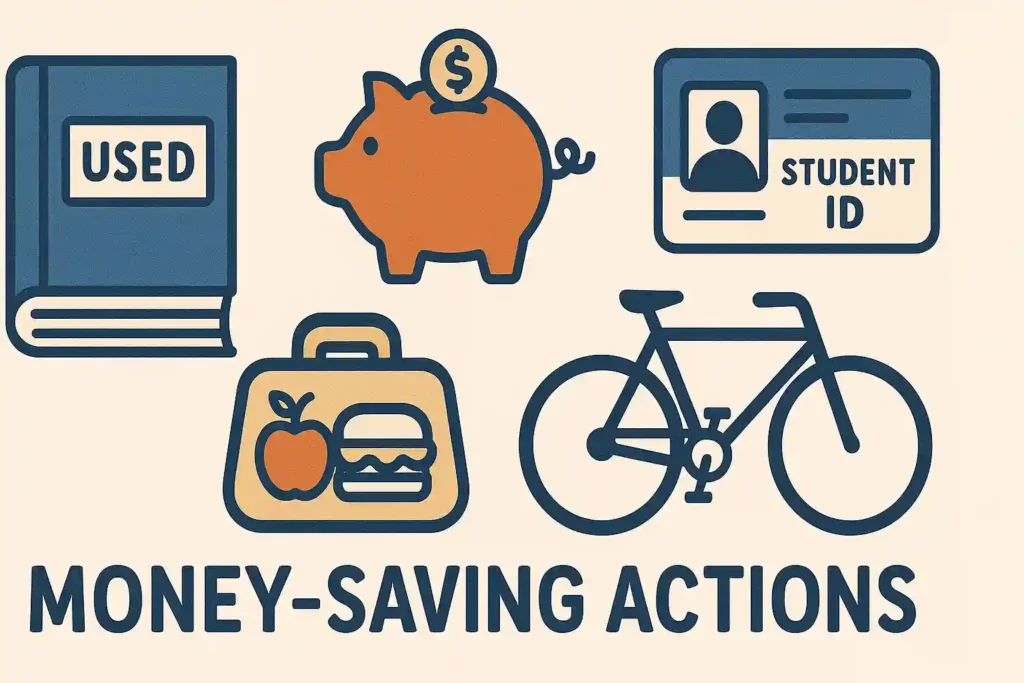Let’s start with a clear definition: A student budget planner is a system, tool, or template specifically designed to help students track their income (often irregular), manage unique expenses (like tuition, textbooks, and social life), save money, and make informed financial decisions during their academic journey. Does the end of the month arrive faster than your student loan disbursement? Are you constantly juggling textbook costs, rent, and trying to have some social life without breaking the bank? Feeling financially stressed as a student is incredibly common, but it doesn’t have to be your reality. Implementing a student budget planner is your key to gaining control, reducing anxiety, and making your money work for you. This ultimate guide will walk you through everything, step-by-step, including practical examples and essential student money saving tips for 2025.
Table of Contents
Why Every Student Needs a Budget Planner (It’s Not Just About Numbers!)
Ignoring your finances during your student years can lead to unnecessary debt and missed opportunities. A budget planner isn’t about restriction; it’s about empowerment. Here’s why it’s non-negotiable:
- Reduces Financial Stress: Knowing where your money is going and having a plan eliminates guesswork and anxiety about affording essentials or upcoming bills.
- Helps Avoid Debt: By tracking spending and setting limits, you’re less likely to rely on credit cards or overdrafts for everyday expenses.
- Achieves Your Goals: Whether saving for a deposit on a flat, a summer trip, or just ensuring you have enough for next semester’s books, a budget directs your money towards what matters.
- Builds Essential Life Skills: Learning effective money management now sets you up for financial stability and success long after graduation.
- Enables Informed Decisions: Can you afford that weekend away? Should you pick up extra shifts? Your budget provides the data to answer these questions confidently.
- Makes the Most of Limited Funds: Student income is often tight. A budget ensures you utilize every pound, dollar, or euro effectively.
Step 1: Gather Your Financial Information (Know Your Numbers)
You can’t create an effective plan without understanding your current financial picture. This involves knowing what’s coming in and where it’s going out.
Identify ALL Your Income Sources
List every source of funds you expect to receive over a specific period (e.g., per semester or per month). Be realistic!
- Student Loans/Finance: Note the total amount per disbursement and the period it needs to cover.
- Grants, Scholarships, Bursaries: Money you don’t need to repay.
- Parental/Family Contributions: Regular allowances or occasional support.
- Part-Time Job Wages: Estimate your average monthly take-home pay (after taxes/deductions). If hours vary, use a conservative estimate or an average over several months.
- Personal Savings: Money you already have set aside.
- Other Sources: Side hustles, selling items online, paid research participation, etc.
Track Your Expenses (The Crucial Reality Check!)
This is often the most eye-opening step. For at least two weeks (ideally a full month), meticulously record everything you spend money on. Use a notebook, a simple spreadsheet, or a phone app. Common student expense categories include:
- Academic Costs:
- Tuition & Fees (if paying directly or portioning loan)
- Textbooks & Course Materials (new, used, rentals)
- Software/Online Subscriptions for courses
- Lab Fees/Equipment
- Living Costs:
- Housing (Rent, Dorm Fees)
- Utilities (Electricity, Gas, Water, Internet – if not included in rent)
- Phone Bill
- Groceries
- Household Supplies/Toiletries
- Food & Drink (Beyond Groceries):
- Dining Out/Takeaways
- Coffee Shops/Cafes
- Vending Machines/Snacks
- Transportation:
- Public Transport (Passes, single tickets)
- Gas/Petrol (if you have a car)
- Car Insurance/Maintenance/Parking
- Ride-Sharing/Taxis
- Personal & Social:
- Clothing & Shoes
- Personal Care (Haircuts, toiletries beyond basics)
- Entertainment (Movies, concerts, streaming services, pubs/clubs, hobbies)
- Social Activities/Events
- Gym/Sports Memberships
- Gifts
- Other:
- Bank Fees
- Credit Card Payments (minimum or extra)
- Unexpected Costs (Medical co-pays, repairs)

Step 2: Choose Your Student Budget Planner Method
The best budget planner is the one you consistently use. Find a tool or system that fits your personality and lifestyle:
The Classic Spreadsheet (Excel/Google Sheets)
- Pros: Free (Google Sheets), highly customizable, great for calculations and visual charts, allows detailed tracking. You can build your own or find many free student budget templates online.
- Cons: Requires manual data entry, needs discipline for regular updates, less convenient for tracking expenses on the go unless using the mobile app versions.
Budgeting Apps
- Pros: Often automate expense tracking by linking to bank accounts (check availability/cost), provide real-time updates, categorize spending, offer visual reports, accessible via phone. Some apps are specifically designed for students or offer student discounts.
- Cons: Some apps have subscription fees (even if starting free), potential privacy/security considerations with linked accounts, may have less customization than spreadsheets. Check if the app supports your local banks/currency.
The Pen-and-Paper Method
- Pros: Simple, tangible, forces mindful recording of spending, no tech required, dedicated budget planner notebooks are available.
- Cons: Entirely manual, easy to forget expenses, hard to analyze trends, requires manual calculations.
Popular Budgeting Rules (Frameworks to Apply)
- The 50/30/20 Rule: Allocate 50% of income to Needs (rent, essential food, transport), 30% to Wants (entertainment, non-essential shopping), and 20% to Savings/Debt. Adjust percentages based on your student situation (e.g., if housing is a large percentage).
- Zero-Based Budgeting: Assign every dollar/pound/euro of income to a specific category (spending or saving) until Income – Expenses = 0. Very intentional.
Step 3: Create Your Budget – Giving Your Money a Job
Using your tracked expenses and chosen method, it’s time to create your actual budget plan:
- Calculate Total Monthly Income: Add up all your reliable income sources for the month (or average period). If you receive large sums (like loan disbursements), divide the amount by the number of months it needs to last and use that monthly figure.
- List Fixed Expenses: Identify costs that are roughly the same each month (rent/dorm, phone bill, set insurance payments, subscription costs, scheduled debt payments). Sum these up.
- Estimate & Allocate Variable Expenses: Using your tracking data as a guide, set realistic spending limits for categories that fluctuate (groceries, dining out, entertainment, transport, personal care). Be honest but intentional. Can you reduce spending in some “Want” categories?
- Prioritize Savings: Treat savings as a non-negotiable expense (“pay yourself first”). Allocate funds, even small amounts, towards:
- Emergency Fund: Aim for at least a small buffer ($500-$1000 or equivalent) for unexpected student-life costs (broken laptop, emergency travel). This is crucial!
- Specific Goals: Saving for a deposit, travel, new equipment, etc.
- Balance Your Budget: Subtract your total planned fixed expenses, variable expense limits, and savings goals from your total monthly income.
- Surplus (+): Excellent! Allocate the extra towards savings, paying down high-interest debt faster, or a specific goal.
- Deficit (-): You’ve planned to spend more than you earn. You must revisit your variable expense limits (especially “Wants”) and reduce them until your budget balances (reaches zero or positive).
- Zero (0): Perfect zero-based budget!
A Sample Budget Plan Example for Students (Adaptable Template)
IMPORTANT DISCLAIMER: This is purely an example to illustrate the structure. Your income, expenses, and priorities will be different. You must personalize this based on your own tracking (Step 1) and situation. Assume a hypothetical monthly income here.
| Category | Estimated Monthly Amount | Notes |
|---|---|---|
| INCOME | ||
| Student Loan (Portion) | $800 | (e.g., $4800 disbursed divided by 6 months) |
| Part-Time Job (Net) | $500 | (Average take-home pay) |
| Family Contribution | $200 | |
| TOTAL INCOME | $1500 | |
| EXPENSES | ||
| Fixed Expenses: | ||
| Rent/Dorm | $600 | |
| Phone Bill | $40 | |
| Internet (if separate) | $30 | |
| Transport Pass | $50 | |
| Subscriptions (Streaming etc.) | $20 | (Review these!) |
| Subtotal Fixed Expenses | $740 | |
| Variable Expenses (Limits): | ||
| Groceries | $250 | (Based on tracking) |
| Dining Out/Takeaways | $100 | (Area to potentially cut) |
| Coffee/Snacks | $40 | (Another potential saving area) |
| Books/Supplies (Avg Monthly) | $50 | (e.g., $300/semester divided by 6 months) |
| Personal Care/Toiletries | $30 | |
| Entertainment/Social | $100 | (Movies, events, hobbies) |
| Clothing/Shopping | $50 | |
| Other Transport (e.g., trips) | $40 | |
| Subtotal Variable Limits | $660 | |
| Savings/Goals: | ||
| Emergency Fund | $50 | (Building towards $500-$1000 goal) |
| Textbooks Fund (Next Semester) | $50 | (Saving ahead) |
| Subtotal Savings | $100 | |
| TOTAL PLANNED OUTFLOWS | $1500 | ($740 Fixed + $660 Variable + $100 Savings) |
| BALANCE (Income – Outflows) | $0 | (This budget balances!) |
Again, customize this heavily! Your numbers will differ. Use this structure as a starting point within your chosen planner (spreadsheet, app, notebook).
Step 4: Track Consistently & Adjust Your Plan (Stay Flexible!)
Your budget planner is a living document, not a one-off exercise.
Regular Check-ins
Review your spending against your budget regularly. A quick daily check-in on an app or a more thorough student weekly budget plan review (e.g., every Sunday) works well. Compare planned spending to actual spending in each category. Did you stick to your limits?
Making Adjustments
Life happens! You might have an unexpected expense (like a dentist visit) or maybe you underspent on groceries.
- Adjust your budget mid-month if needed. If you overspend in one variable category, try to cut back in another “Want” category to compensate.
- If a true emergency hits, use your emergency fund (and make a plan to replenish it).
- If your income changes significantly, revise your entire budget.
Top Student Money Saving Tips (Boost Your Budget!)
Budgeting helps manage what you have; these tips help you keep more of it!

- Textbooks: Buy used, rent (online or campus stores), check the library, share with classmates, or sell back previous semester books. Avoid new whenever possible.
- Student Discounts: Flash your student ID everywhere! Transport (railcards!), shops, cinemas, restaurants, software – many offer discounts. Use apps like UNiDAYS or TOTUM (UK).
- Food Costs: Cook at home! Plan meals, buy store brands, utilize budget supermarkets (like Aldi/Lidl), pack lunches, make your own coffee. Limit expensive takeaways and frequent cafe visits.
- Free Fun: Explore free campus events, join societies, visit parks/museums on free days, utilize library resources (books, movies, digital access).
- Smart Transport: Walk, cycle, or use discounted student public transport passes instead of driving or relying on taxis/ride-sharing.
- Subscription Review: Audit streaming services, gym memberships, software trials. Cancel what you don’t use regularly or look for student plans.
- Avoid Impulse Buys: Implement a 24-hour waiting period for non-essential purchases. Ask yourself if you really need it.
- Second-Hand First: Consider charity shops, online marketplaces (Facebook Marketplace, Vinted, Depop), or campus groups for clothes, furniture, and other items before buying new.
Dealing with Student Loans in Your Budget
For many, student loans are a major income source and future expense. Budget them wisely:
- Treat Disbursements Carefully: When a large loan payment hits your account, resist the urge to spend freely. Divide it by the number of months it needs to last and allocate that monthly amount as income in your budget planner. Keep the rest safely aside (e.g., in a linked savings account).
- Borrow Only What You Need: While it might be tempting to take the maximum offered, borrowing less means lower repayments later. Try to cover living costs through other means (work, savings) if possible.
- Understand Your Terms: Know your loan types (federal/private), interest rates (fixed/variable), grace periods, and when repayment starts. Resources like StudentAid.gov (US) or your country’s equivalent government student finance portal are essential.
- Plan Ahead for Repayment: Even if repayment seems far off, start thinking about it. Understanding potential monthly payments helps motivate responsible borrowing now.
Helpful Resources for Student Budgeting
Leverage support available to you:
- University Financial Aid/Money Advice Service: Most universities offer free, confidential advice, workshops, budgeting tools, and information on hardship funds. Check their website!
- Government Student Finance Websites: Provide official information on loans, grants, and repayment options (e.g., StudentAid.gov, gov.uk/student-finance).
- Reputable Financial Literacy Websites: Non-profits like the National Endowment for Financial Education (NEFE.org) or government bodies like the Consumer Financial Protection Bureau (CFPB.gov) offer unbiased resources.
Conclusion: Your Path to Financial Confidence as a Student
Implementing a student budget planner system isn’t about depriving yourself; it’s about giving yourself control, clarity, and confidence. By diligently tracking your income and expenses, choosing a method you’ll stick with, creating a realistic plan (like the budget plan example for students shown, but personalized!), consistently monitoring your progress, and employing smart student money saving tips, you transform your relationship with money.
You’ll face challenges and might need to adjust your plan – that’s normal. The key is consistency and learning from experience. Start small if you need to, perhaps just tracking expenses for a week, but start. Mastering this skill now will pay dividends long after graduation, empowering you to achieve your goals and navigate life with greater financial peace of mind.
Frequently Asked Questions (FAQ)
How do I create a budget plan as a student if my income is irregular (part-time job)?
Budget based on your minimum guaranteed or lowest likely monthly income. Cover essentials with that amount. Any extra income earned above that baseline can then be allocated flexibly – perhaps split between extra savings, faster debt repayment (if applicable), or adding a bit more to your ‘Wants’ categories for that month.
What is a good or realistic budget amount for a student per week/month?
There’s no single answer! It depends heavily on your location’s cost of living, accommodation type, tuition fees, lifestyle choices, and income sources. The only way to determine a realistic budget for you is by tracking your actual expenses and aligning them with your actual income. Focus on making your numbers balance, not comparing specific amounts to others.
How can a student manage money effectively beyond just budgeting?
Effective management includes: setting clear financial goals (short and long-term), building an emergency fund (even a small one), actively seeking ways to save (discounts, cooking at home), understanding any debt you have (especially student loans), avoiding high-interest credit card debt, and continuously learning about personal finance.
What are the first steps to creating a student budget?
1) Track your spending for a period (like 2-4 weeks) to see where your money actually goes. 2) Identify all your income sources for a typical month or semester. 3) Categorize your expenses into fixed (rent, phone) and variable (food, entertainment). 4) Choose a budgeting tool (app, spreadsheet, paper). 5) Allocate your income to cover expenses and savings goals, ensuring outflows don’t exceed inflows.
How often should I review and update my student budget planner?
Track expenses frequently (daily or every few days). Review your progress against the budget weekly or bi-weekly to stay on track and make small adjustments. Do a more thorough review and plan for the upcoming month at least once monthly. Revisit and potentially overhaul your budget whenever significant changes occur (new job, rent increase, change in financial aid).



